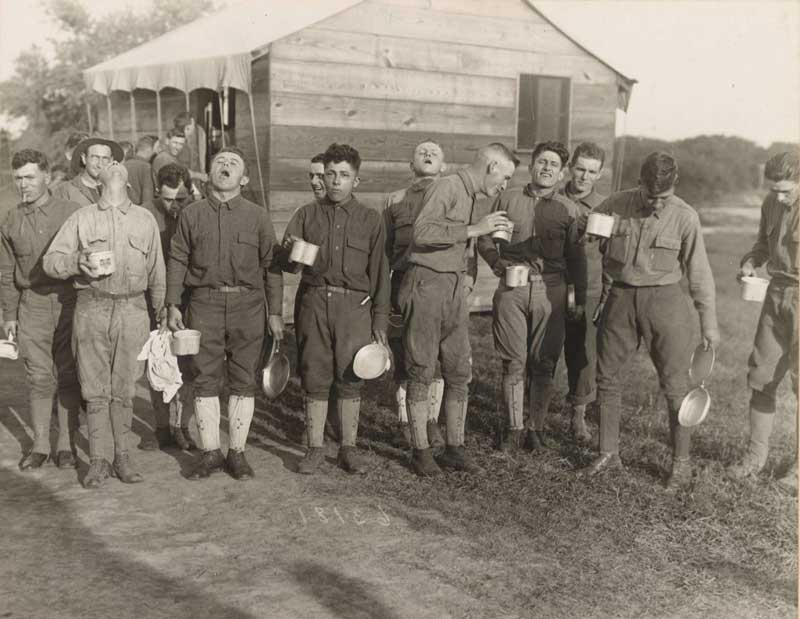
There is great debate about how the scourge arrived in Canada.
Did it come north with U.S. soldiers shipping out through Canada? The epidemic hit Camp Funston in Kansas in January. Since it was contagious before symptoms first appeared, it spread along rail lines from camp to camp, then to troopships bound for Europe.
Did it arrive with the 94,000 Chinese Labour Corps workers bound for the front lines in Europe, who crossed Canada in sealed cars in March 1918? Cases with similar symptoms—patients turning blue from lack of oxygen and coughing up blood—were recorded in northern China in 1917.
The initial wave of the disease in the spring of 1918 was mild. The first record of a Canadian death was that of Marjory MacDonald on Sept. 1, 1918, in Nova Scotia, as the epidemic rapidly spread across the province. The Chinese labourers, as well as thousands of soldiers from the U.S., shipped out of Halifax bound for Europe. Deaths were recorded in Quebec on Sept. 16, and in Ontario on Sept. 18.
The military was ideal for incubating and spreading the disease. Soldiers on both sides of the conflict were easy prey because they lived and travelled in large groups in abominable conditions. Crowded spaces and life in the trenches wreaked havoc on their immune systems, which were already coping with stress, dirt, hunger and cold.
“It struck all the armies and might have claimed toward 100,000 fatalities among soldiers overall during the conflict, while rendering millions ineffective,” according to Dutch military historians Peter C. Wever and Leo van Bergen. More than a quarter of the U.S. army was sickened, and 30,000 men died in training camps. More than 14,000 German troops died from influenza.
During the last four months of the war, 11,496 Canadian soldiers fell ill at home (some 400 died), as well as 46,000 members of the Canadian Expeditionary Force overseas, 776 of whom died, reported Andrew MacPhail in his 1925 book, The Official History of the Canadian Army Medical Service 1914-19.
Information was slower to travel than the bug itself.
It might have been worse for troops in combat, but Canada noted infectious diseases arrived with new recruits, causing isolation camps to be put in place in 1916, wrote MacPhail. Not only did the epidemic force the original camps to expand, a new one was also established.
But there was no such hurdle back home. The plague spread across Canada in just one week in September.
The first contingent of the Siberian Expeditionary Force, headed west to Russia to help quell the Bolshevik revolution, left New Brunswick on Sept. 27, and sick men were offloaded in every major city along the rail line from Toronto, wrote Captain Eric Elkington. On Oct. 2, 1918, the soldiers, and the flu, arrived in Vancouver.
The disease seemed to be everywhere at once and moved so rapidly local health officials were taken by surprise. The sick were isolated and provinces and municipalities banned large gatherings, and closed schools, businesses and churches and issued mask mandates.
Information was slower to travel than the bug itself. News was widely censored, and the epidemic only became public knowledge once it was front-page news in neutral Spain when King Alfonso was infected. Though it did not originate there, the disease became known as the Spanish flu.
Pundits, such as Frank Oliver of the Edmonton Bulletin, wrote of criminal negligence of military authorities, who “refuse to allow information to be given out as to the number of deaths.” And Calgary newspaperman, William Irvine, asked, “where was the Order-in-Council prohibiting all travel until such time as the plague subsided?”
The pandemic took a back seat to the war effort in Canada, where troops continued to be recruited and enlist—and were transported across the country, along with the flu.
Jesse Brinson of Western Arm, Nfld., was one of the few soldiers to blame himself for spreading the infection.
He was in a military hospital where “there was a soldier buried every day for eight days. I wrote a letter, had no better sense…[and sent] the disease right in the family to take the whole lot of them out the one day,” he said in a Heroes Remember video produced by Veterans Affairs Canada.
The pandemic took a back seat to the war effort in Canada, where troops continued to be recruited and enlist—and were transported across the country, along with the flu.
The flu spread not with “injured soldiers returning home from the muddy battlefields of Europe, but with new recruits bound for a new front in Asia,” wrote historian Mark Osborne Humphries in The Last Plague: Spanish Influenza and the Politics of Public Health in Canada.
In response, the federal Department of Health was created in 1919 to co-ordinate policies and procedures across the country. Each province and territory subsequently developed pandemic response plans, which included plans for mass vaccinations, quarantine guidelines and stipulations for public health measures, such as mandatory masks and social distancing guidelines.
About 50,000 of Canada’s eight million people died during the two years the Spanish flu raged at the end of the First World War. As of Oct. 1, 2022, of Canada’s 38 million population, the COVID-19 pandemic had claimed a little more than 45,000 people.
This time around, the military did not contribute to spread of the disease, but helped deal with it.
Advertisement












